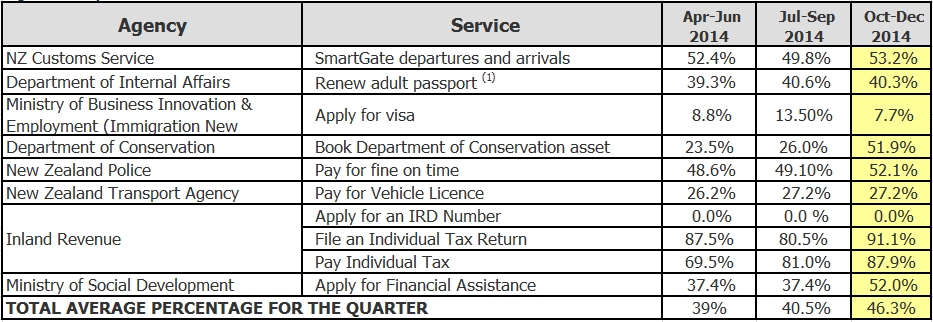Published on the 01/05/2015 | Written by Clare Coulson

Some departments have a long way to go to hit the ‘Better Public Services’ 2017 targets for online transactions…
The Government has set itself some aggressive targets as it moves towards interacting with citizens via efficient and easy-to-use online tools.
The Better Public Services programme, launched by John Key back in 2012, listed 10 key ‘Result’ areas of improvement that government wanted to achieve. These included Results 9 and 10 which focused on ‘improving interaction with government’ and a very specific goal that 70 percent of New Zealanders’ 10 most common government transactions would be fulfilled online by 2017.
The Department of Internal Affairs (DIA) is the lead agency for Results 9 and 10. The most recent measurements show that as of the end of last year less than half (46 percent) of users were completing the transactions online, suggesting that the government has a long way to go if it is to reach its target on deadline.
DIA general manager of digital transformation, Richard Foy, is unconcerned, however: “We have a really high degree of confidence in meeting that measure because we’ve got forecasts from the various agencies involved.”
Foy wouldn’t share what those forecasts were because they are “a little bit more volatile”, but said the DIA is confident that the various plans at the different agencies will get the government just over the 70 percent mark by 2017.
Mike Smith, practice lead at UXC Oxygen which is involved in delivering the Better Public Services programme said: “There is a clear focus on Result 9 and Result 10 in the conversations I have daily with stakeholders and vendors in the public sector.”
Some agencies showed extremely encouraging results, whereas others showed minimal improvements or even a small drop since the previous quarter. Foy put these fluctuations down to seasonal trends and specific marketing campaigns to drive users online. He said that the overall trend is tracking up, showing that New Zealanders are more and more comfortable making government-related transactions online. Foy did admit, however, that the government needs to get savvier around digital marketing and promoting these easier ways of doing things online.
The Inland Revenue Department (IRD) is leading the charge with 91 percent of individuals filing their tax return online. Visa applications are proving the laggard at just 7.7 percent, and perhaps the reason why online completion of some visa applications are now compulsory. Smith said that there is increasing digital uptake at the IRD and it makes sense that it is leading the way with electronic services to complete GST and tax returns.
Source: http://www.dia.govt.nz/Better-Public-Services-Measuring-Result-10
“As a role model for Result 10, they need to ensure the citizen is front and centre, and improve the ease and overall experience with not only IRD, but also those other agencies and organisations that the citizen is transacting across,” he said.
Foy confirmed the importance of ease of use in the DIA’s plans. “We are now focusing less on the 70 percent metric, which is purely a quantative measure, and more on the qualitative aspect of the service experience,” he said, adding that the easier services are to use online, the more people will use them.
This qualitative aspect gets to the heart of Result 10, which specifies that New Zealanders must be able to complete their “transactions with government easily in a digital environment”. Foy says that the DIA’s research overwhelmingly shows that New Zealanders expect their interactions with government to be much more integrated so one of the key changes the DIA is making as a result is integrating services around what he calls “life events” such as the birth of a child.
“Integrating services around the customer means taking an outside-in point of view and looking at what services need to be bundled together and integrated when they get offered to the customer. We are working on some of those proactively on the www.govt.nz website,” he said.
Foy outlined the importance of the government’s world-leading RealMe identification verification and login tool saying it will play a key role in enabling this cross-agency ease of use. Registrations for the RealMe service increased significantly during the general election last year and the DIA has seen re-use rates of the RealMe login increase from 29 percent a year ago to 51 percent today across multiple services. Foy agreed however that there is still some misunderstanding around the RealMe login and wanted to stress that it is a distributed, privacy-protected, consent-based service which puts New Zealanders in control of how the information stored in their RealMe account gets re-used by government agencies.




























